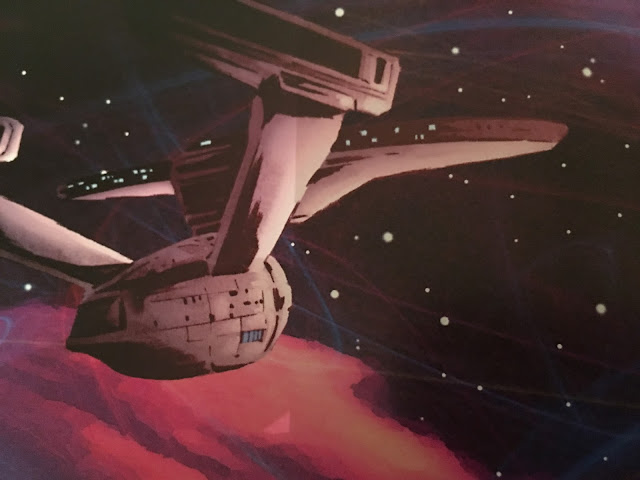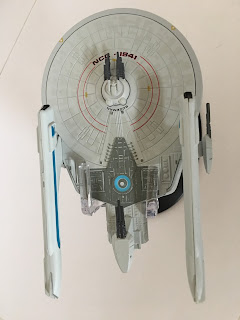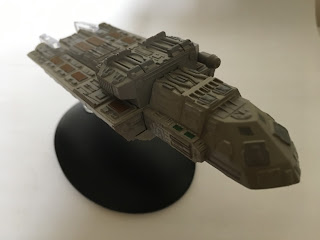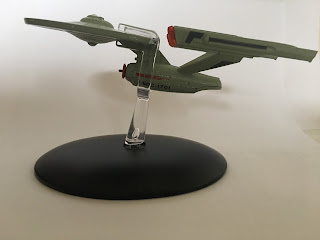Bringing us more up to date with the Graphic Novel Collection, here are the next four in our recap sessions...
The Newspaper Strips Vol 2 is another of those that I find hard to digest in anything less than a handful of reading sessions. The content itself though is way above that of The Classic UK Comic Strips using the source material much more closely and drawing on the past of the franchise to really fill out the action.
Set after the events of The Motion Picture and using the rather bland range of unitard uniforms, Kirk and crew are depicted returning to the unknown in some truly beautifully illustrated stories.
Given their nature of being a newspaper comic strip each bite of the tale is punchy and leaves you on a pretty abrupt cliffhanging moment each time. The stories aren't too deep either with Klingon and alien attacks plus a par-for-the-course virus and the return of the mustachioed Harcourt Fenton Mudd to round out the adventures.
Honestly though, for me the artwork in this volume is just standout gorgeous flicking between colour and black and white but for something produced at such a pivotal time in Star Trek history, the way in which the artists have captured the likenesses of the crew and the ship is truly striking. It's also a lovely precursor to the more visually accurate material of the 80's and beyond and goes to show that Star Trek was being taken much more seriously as a product. It was finally getting the proper treatment it deserved on the page rather than being just a jaded knock off from 50's serials that had nothing to do with Roddenberry's vision. I'm not saying that these strips are perfect, far from it because they do still tend to lean towards the fantastical rather than the human condition (but then would you really want something that deep in a daily newspaper strip?) but they are at least heading in a familiar and grounded direction.
 Star Trek After Darkness offers a chance to see what happened in the years between the end of the second JJ movie and Beyond. Including Carol Marcus, the Enterprise crew take on a series of new adventures as they, finally, go where no one has gone before.
Star Trek After Darkness offers a chance to see what happened in the years between the end of the second JJ movie and Beyond. Including Carol Marcus, the Enterprise crew take on a series of new adventures as they, finally, go where no one has gone before.Choosing not only to look into the future (as they thought then), After Darkness also flips back in time to give us the origin stories for both Chekov and Scotty which led them to their appearances in the 2009 reboot. As always the writing and artwork in these fairly recent offerings are magnificent and thoroughly engrossing giving much more depth to the JJ-verse which is sorely needed since its novel line was cancelled and there is a minimal amount of screentime to refer back to.
The third of these stories might cause a bit of controversy since it chooses to tackle Vulcan Ponn Farr and therefore effectively rewrite the events of Amok Time. This one heads into a lot darker corridors than Spock taking chunks out of Kirk with a giant cotton bud on Vulcan, pushing him right to the edge of sanity and back again. It's a brave choice to tackle such a reverred point in The Original Series but then these volumes have never shied away from a challenge as we've seen in reworkings of other classics such as Where No Man Has Gone Before and The Galileo Seven. Here though it's a big leap and I believe it pays off because it is such a different spin on events.
I continue to be a fan of these Kelvin Timeline stories because of their risk taking with recognised events and the different ways they have faced the change in circumstances following the arrival of Nero and his converted mining ship. Looking forward to the next one of these already!
Khan - Ruling in Hell is just a graphic novel masterpiece without question and one of the highlights of the whole damn series.
Storywise this covers everything from the moment Kirk and the Enterprise dropped the Botany Bay at Ceti Alpha V right up to the very end of The Wrath of Khan. The artwork is brilliant, encapsulating the dangers and adventures that befall the genetic superhumans before the neighbouring sixth planet explodes and alters the orbit of their enforced home.
As with Assignment: Earth it also takes us ostensibly away from the Enterprise and her mission to something very, very different. We see Khan endure the highs of the challenge to colonise his new world through to the crushing death of his wife as well as internal attempts from his own people to overthrow him.
The recreation of The Wrath of Khan is another classic comic strip that condenses the landmark Star Trek movie into a great read. The characterisation of Khan, Joachim and even McGivers is tremendous with some fantastic and very accurate artwork to back it all up.
As with Assignment: Earth it also takes us ostensibly away from the Enterprise and her mission to something very, very different. We see Khan endure the highs of the challenge to colonise his new world through to the crushing death of his wife as well as internal attempts from his own people to overthrow him.
The recreation of The Wrath of Khan is another classic comic strip that condenses the landmark Star Trek movie into a great read. The characterisation of Khan, Joachim and even McGivers is tremendous with some fantastic and very accurate artwork to back it all up.
It took me about seven pages before I realised that I’d actually read issue one of the TNG: Beginnings collection back in c.1989 just when The Next Generation has launched on UK TV. In fact the back of the comic had been filled with a plot synopsis and pics from the upcoming episode, Datalore.
How did I remember? Because of the bloody annoying Bickering Bickleys. One of the worst things to ever grace any part of the franchise...so pretty fortunate that while they do turn up with more frightening regularity than I would like, they aren’t prominently featured in any of the tales contained therein.
Beginnings is as odd a beast to the Star Trek graphic novels as the Divided We Fall crossover that was only released a few months ago in that it offers a perspective on familiar characters if things had developed a different way. To be honest things would have had to develop in a rather severe manner for these interpretations of the Enterprise-D crew to manifest so count yourselves lucky.
You can tell how early in the development of The Next Generation this series came about because of the way that some of the crew are portrayed. Notably Data uses contractions all over the place, gets emotional and even starts a fight. Deanna seems to have varying abilities given the needs of the story from latent telepathy to full blown psychic waves. As for Wesley he’s even more super annoying than he ever was in the first season on TV, ranging from being a super nerd through to a precocious best at the other extreme.
Beginnings does have some bits right with Riker more in charge of away missions and Picard remaining on the Enterprise although everyone seems to have had an incredible workout regime looking like stars from a body building magazine including the captain.
In all fairness some of the stories do drone on a bit but because of the inconsistencies between page and screen I did find this difficult to get into 30 years after I read the first issue. The artwork is far too stylised for me when it comes to the portrayal of the cast and their physiques plus the likenesses are far from accurate especially Data and Q is virtually unrecognisable. Actually on that count he’s unrecognisable in both form and character and while this story does parallel events from Deja Q I never recall De Lancie ever becoming this obnoxious even at Q’s worst moments.
What a lot of these graphic novel installments show are the various directions Star Trek could have gone in if onscreen events had transpired in a different manner. It also illustrates what the opinion of these writers was as to what the franchise stood for and what they understood it should be. Each of the stories is incredibly individualistic and Beginnings especially offers a perspective that we never even got slightly close to in the TV series of The Next Generation. These stories are as prolific as they are conceptual and getting into this batch really offers something new - perhaps not great - but definitely new to the Star Trek universe.
As ever these issues wouldn't be half the fun without the wonders of the Gold Key universe and its gradual - very gradual - work towards looking something like Star Trek. With these editions we can engage with the fantastical universe once again in The Mummies of Heitius VII, Siege in Superspace and Child's Play. For note, the Newspaper Strips volume does not contain a Gold Key story (phew - a break!). Utter escapism every time and none to serious. It's almost as if Gold Key realised it was in fact parodying itself through its own writing...
Next up we have issues 28 - 31 which brings us (almost) bang up to date.
What a lot of these graphic novel installments show are the various directions Star Trek could have gone in if onscreen events had transpired in a different manner. It also illustrates what the opinion of these writers was as to what the franchise stood for and what they understood it should be. Each of the stories is incredibly individualistic and Beginnings especially offers a perspective that we never even got slightly close to in the TV series of The Next Generation. These stories are as prolific as they are conceptual and getting into this batch really offers something new - perhaps not great - but definitely new to the Star Trek universe.
As ever these issues wouldn't be half the fun without the wonders of the Gold Key universe and its gradual - very gradual - work towards looking something like Star Trek. With these editions we can engage with the fantastical universe once again in The Mummies of Heitius VII, Siege in Superspace and Child's Play. For note, the Newspaper Strips volume does not contain a Gold Key story (phew - a break!). Utter escapism every time and none to serious. It's almost as if Gold Key realised it was in fact parodying itself through its own writing...
Next up we have issues 28 - 31 which brings us (almost) bang up to date.
Follow us on Twitter
+1 us on Google+
Add us on Tumblr


































